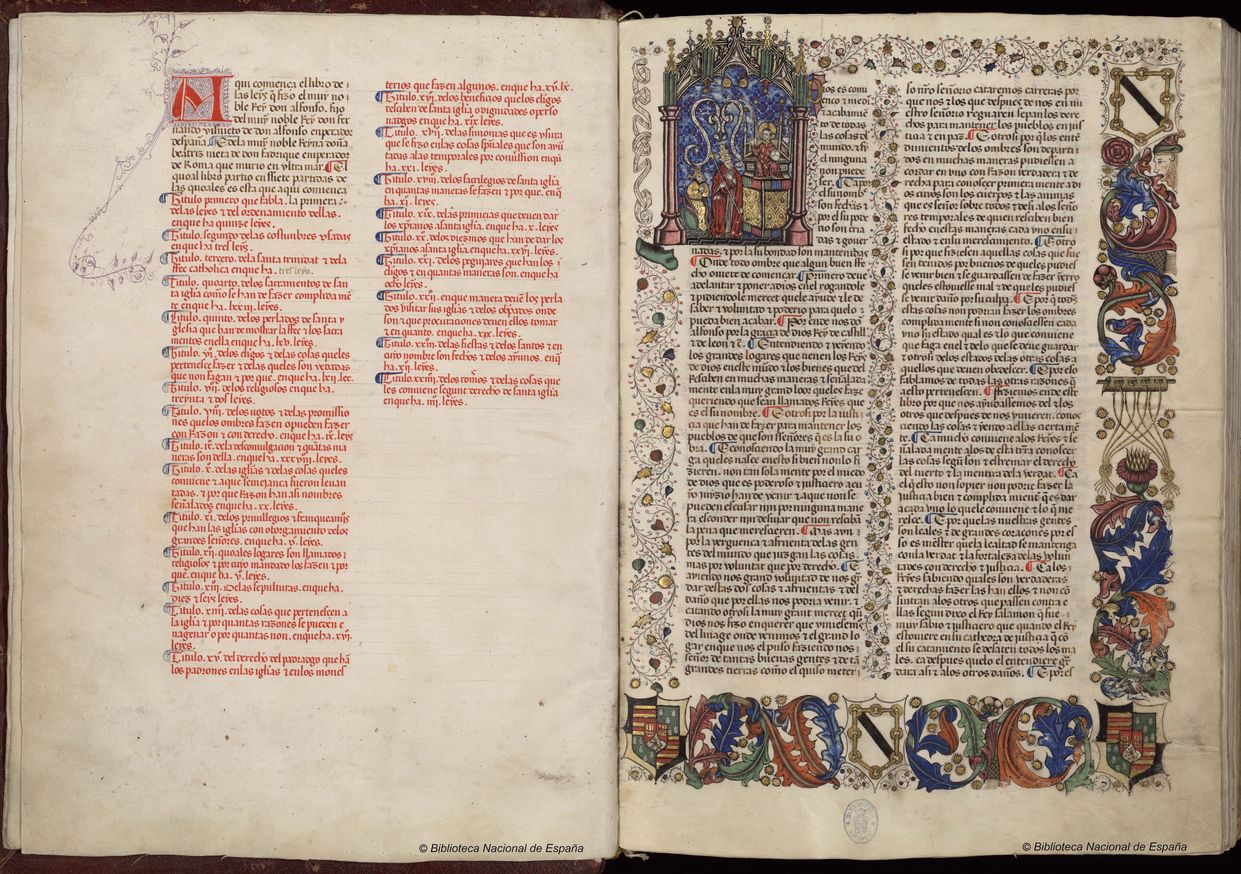Century XIII


![Ver [Alfonso X of Castile; 1265] en referencias bibliográficas. Libro abierto, hojas de plata, filo de oro, guardas de gules, tapas de sable.](../css/Libro.Bibliografia.png)
Alfonso X of Castile; 1265
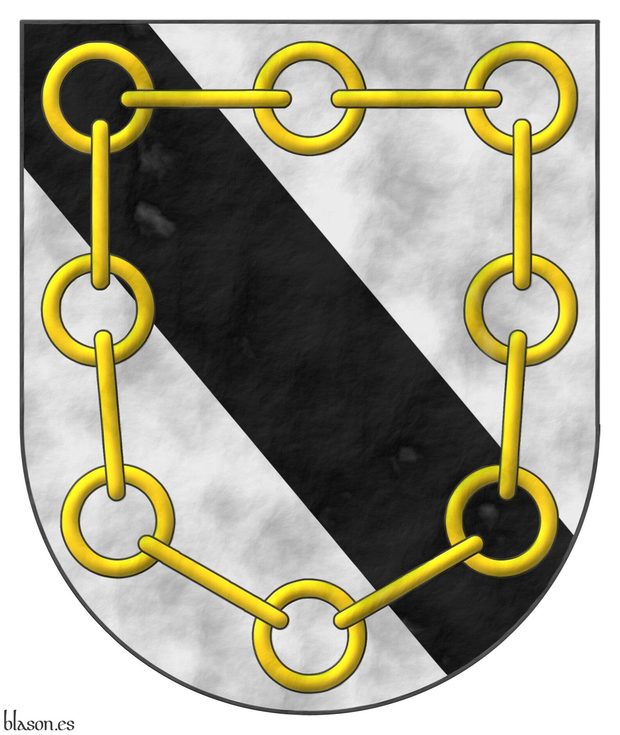
Alfonso X of Castile, The Wise, «The Seven-Part Code», its estimated completion year is 1265.
This is the copy I can consult, as it is available in the Hispanic Digital Library, it is a manuscript measuring 42 by 30 centimeters that once belonged to Álvaro de Zúñiga y Guzmán, first Duke of Arévalo, which later came into the possession of the Catholic Monarchs, initially Queen Isabella I of Castile, and after her death, King Ferdinand reclaimed it for the price of 5,251 maravedis. The original is housed in the National Library, in display case 4/6.
This copy, in addition to its numerous capital letters, has 8 illustrated pages, which according to its subsequent hand-numbering in pencil are:
- Page 6, among its illustrations can be seen 2 coats of arms of the Zúñiga family «Argent, a bend Sable, over all, a chain in orle Or», in this case formed by 16 links, 8 round and 8 more elongated placed in profile.
- Pages 106 and 191, on the latter can be seen a curious bishop-lizard climbing.
- Pages 294 and 331, on the 2nd at the bottom, a maiden is seen walking a monkey to relieve itself and to her right a fight of men with beast bodies.
- Page 379 and on its previous unnumbered page, and finally, on page 415 which begins with a tournament where the 2nd knight bears the ancient arms of France «Azure, semy of fleurs de lis Or».
The coat of arms that illustrates this bibliographic reference is that of Álvaro de Zúñiga y Guzmán. For the creation of his chain, I followed the illustration of his 2 coats of arms on the already mentioned page 6 of this manuscript.
It is one of my favorite manuscripts and, perhaps, the one with which I have created the most things.
Bibliographical reference of century XIII.
Classification: Castilian language, Manuscript and In color.
Author: Alfonso X of Castile.
Bibliographical reference mentioned in the following article:
External resources:
- National Library of Spain.
- Indirect access to the Library of Congress of the United States of America.
- Direct access to the Library of Congress of the United States of America.
Internal resources: AlfonsoXDeCastilla1265.7Partidas.10642.pdf.


![Ver [Charles' Roll; 1285] en referencias bibliográficas. Libro abierto, hojas de plata, filo de oro, guardas de gules, tapas de sable.](../css/Libro.Bibliografia.png)
Charles' Roll; 1285
«Charles's Roll», containing 486 painted coats of arms, it is an English roll of arms dating from c. 1285.
Charles' Roll, housed in the Society of Antiquaries, London, and cataloged as MS517, is a 15th-century English roll of arms, originally created around 1285, containing 486 painted coats of arms. The antiquary James Robinson Planché identified «Charles's Roll» as a copy of a mid-13th-century roll, British Library, Harley MS 6589, featuring nearly 700 coats of arms, drawn by Nicholas Charles, Lancaster Herald, in 1607. Charles mentioned that the original roll had been lent to him by the Norroy King of Arms.
Bibliographical reference of century XIII.
Classification: Armorial roll, Manuscript and In color.
The author is unknown.
Bibliographic reference mentioned in the following articles:


![Ver [Febrer, J.; Century XIII] en referencias bibliográficas. Libro abierto, hojas de plata, filo de oro, guardas de gules, tapas de sable.](../css/Libro.Bibliografia.png)
Febrer, J.; Century XIII
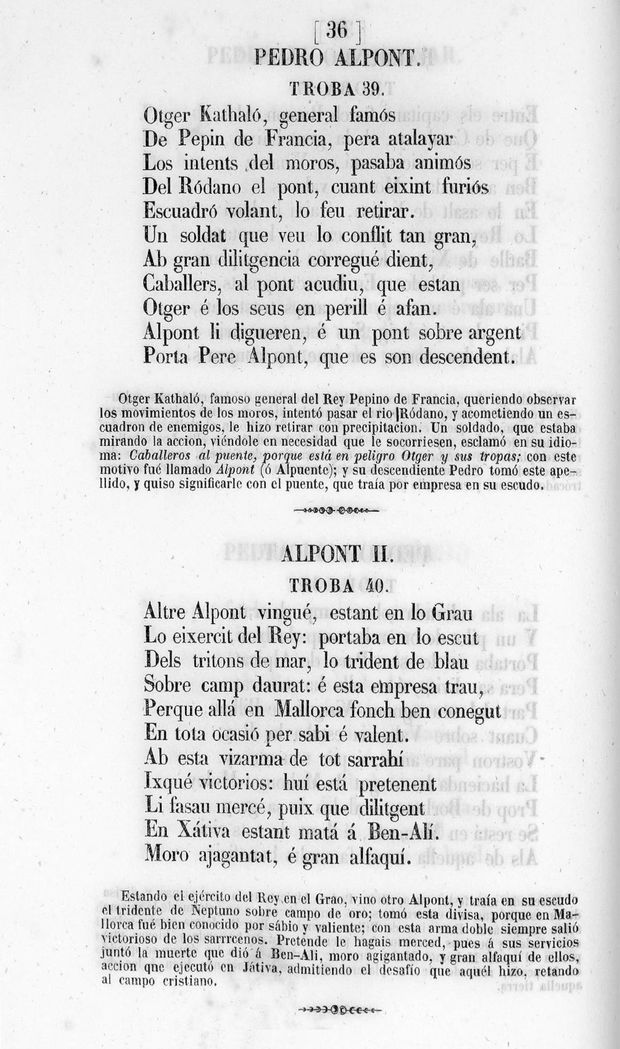
Jaime Febrer, «Trovas de Mossen Jaime Febrer: que tratan de los conquistadores de Valencia», edited by Joaquín María Bover, new edition made with reference to the first and an old manuscript, with notes, illustrated with portrait plates and heraldic plates, 312 pages, printed by Pedro José Gelabert, Palma, 1848.
Historical context and content
Jaime Febrer lived during the reigns of Jaime I El Conquistador, 1207-1276, and his son Pedro III El Grande of Aragon and I of Valencia, 1239-1285. Febrer is believed to have authored a manuscript detailing 278 knights who participated in the conquest of Valencia alongside Jaime I, forming the foundation of many noble lineages in the city and kingdom of Valencia.
The manuscript, dedicated to Pedro III and I of Valencia, is composed in short verses known as «trovas» ~ «trobas», written in the «Lemosín» language, an old form of Valencian. Each trova includes a description of the knights' coats of arms.
A re-edition of this manuscript was published by Joaquín María Bover in 1848 in Palma de Mallorca.
Illustrative example of trova 39, Alpont
The «trova 39» is dedicated to Pedro Alpont, whose ancestor helped the General Otger Kathaló and adopted the surname Alpont following an event involving a bridge. This poem «trova 39» serves as an illustrative example, describing the blazon of Pedro Alpont. The blazon described in this trova is simple: «Argent, a Bridge».
The story included in this trova tells how Otger Gotlant, also known as Oger Catalón or Catazlon, a general under King Pepin of France, was near the Rhône observing the Moors. He crossed the river by one of its bridges to better track the enemy’s movements. Suddenly, he was attacked by a squadron of Saracens, forcing him to retreat hastily. A soldier on the other side of the river saw this and began shouting in the Lemosín language, calling for reinforcements: «Al pont, caballers, al pont» ~ «To the bridge, knights, to the bridge», as Otger and his men were in danger. According to this «trova 39» by Jaime Febrer, from that moment on, this soldier was known by the surname Alpont. One of his descendants, named Pedro Alpont, participated in the conquest of Mallorca and later moved to Valencia, following King Jaime I El Conquistador, leaving behind the Alpont surname for his successors.
Another Alpont, referred to as Alpont II, appears in trova number 40, where his blazon is characterized by a trident.
Bibliographical reference of century XIII.
Classification: Valencian language and In black and white.
Author: Febrer, Jaime.
External resource:
Internal resources: FebrerJXIII.Trobas.BoverJM1848.Parcial.155.Paginas.pdf Partial PDF with the first 155 pages.


![Ver [Heralds' Roll, T.; 1280] en referencias bibliográficas. Libro abierto, hojas de plata, filo de oro, guardas de gules, tapas de sable.](../css/Libro.Bibliografia.png)
Heralds' Roll, T.; 1280
«The Heralds' Roll», containing 697 painted coats of arms, it is an English roll of arms dating from c. 1280.
In The Fitzwilliam Museum, Cambridge, with code MS297, there is a copy of the 15th century.
Bibliographical reference of century XIII.
Classification: Armorial roll, Manuscript and In color.
The author is anonymous.
Here are the articles quoting this reference:
External links:


![Ver [Marshal, L.; 1295] en referencias bibliográficas. Libro abierto, hojas de plata, filo de oro, guardas de gules, tapas de sable.](../css/Libro.Bibliografia.png)
Marshal, L.; 1295
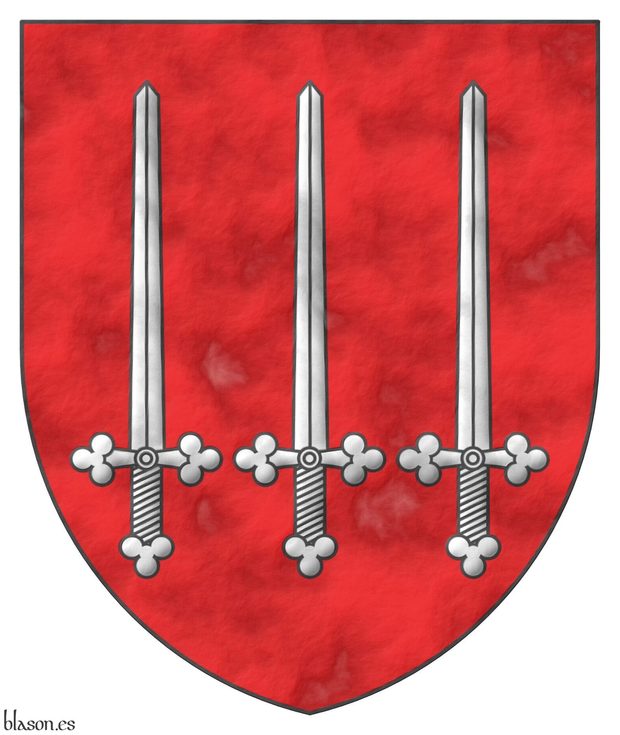
Lord Marshal, «The Lord Marshal's Roll», deposited in the Society of Antiquaries of London, code ms664, volume 1, ff 19-25, contains 565 painted shields, of which 42 are blank and 48 do not have the name of their associated holder, dated 1295.
This armorial contains the systematic error of representing, in many of its registered shields, the metal gold as metal silver, and some of its shields are not easy to decipher. Therefore, this armorial cannot be considered a completely reliable and definitive source of certain coats of arms.
[Brault, G. J.; 1997] is a good reference for the analysis of this armorial and in Brian Timms you can see a current interpretation of the coats of arms recorded in it, among them the shield of William de Colebrand that illustrates this bibliographic reference.
At the beginning of the second half of the 13th century, the use of coats of arms increased, this increase led to the appearance of the first armorials in which the name of their holders was recorded along with the blazon describing their coats of arms, possibly including the painted shields.
Bibliographical reference of century XIII.
Author: Marshal, Lord.
Bibliographic reference mentioned in the following articles:
External link:


![Ver [St. George's Roll; 1285] en referencias bibliográficas. Libro abierto, hojas de plata, filo de oro, guardas de gules, tapas de sable.](../css/Libro.Bibliografia.png)
St. George's Roll; 1285
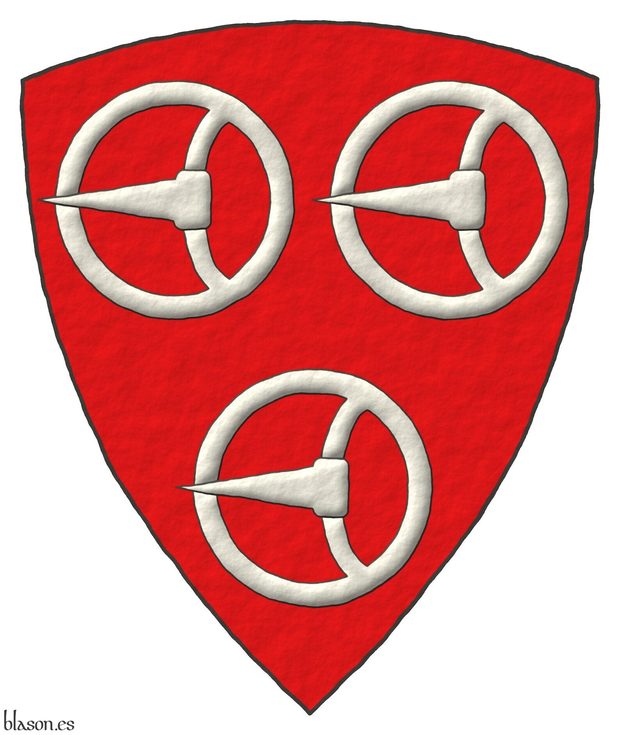
St. George's Roll, in English usually written as «MS Vincent, 164 ff.1-21b», also called [Vincent, MS; 1285], it is in the College of Arms, London, containing 677 painted coats of arms, it is an English roll or arms dating from c. 1285.
The bibliographical reference that I mainly use for this armorial is [Vincent, MS; 1285].
Bibliographical reference of century XIII.
Classification: Armorial roll and Manuscript.
The author is anonymous.
The following articles cite this bibliographic reference:
- Adam de Cretingges
- Bartholomew de Yattendon
- Brian Timms
- Edmund de Bassingburnn
- Howel ap Res
- James de Sottone, le Fitz
- Joan de Okinton
- John de Beauchamp
- John de Ladbrooke
- John le Sturmy
- Nicholas Malmains
- Norman Darcy
- Ricardo de Mandeville
- Robert de Malet
- Simon de Crombe
- Simon de Ver
- Simon le FizSimon
- Thomas Roscelyn
- Thomas de Werblintone
- Thomas le FizThomas
- Vincent, MS; 1285
- Warbrentone, Thomas de
- William Bardolf
- William de Ferrers, Earl of Derby
- William de Hondeshacre


![Ver [Vincent, MS; 1285] en referencias bibliográficas. Libro abierto, hojas de plata, filo de oro, guardas de gules, tapas de sable.](../css/Libro.Bibliografia.png)
Vincent, MS; 1285
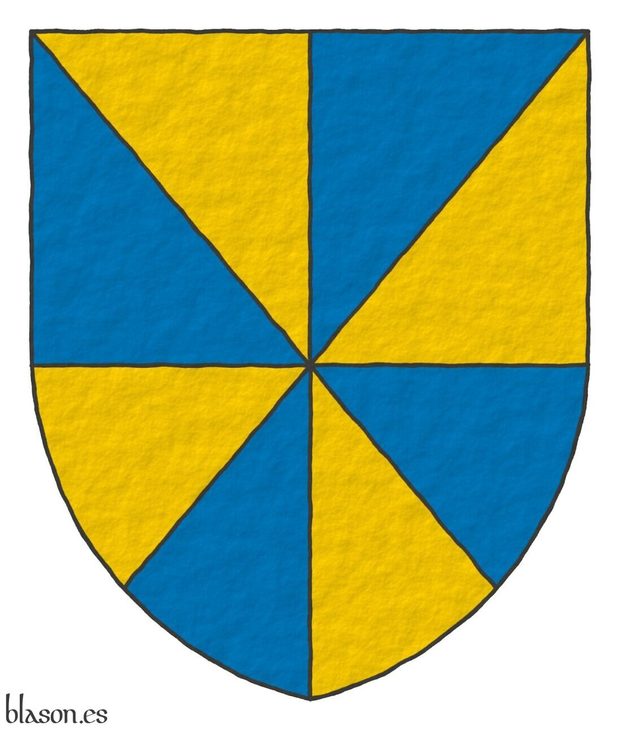
Vincent Manuscript, in English, usually written as «MS Vincent, 164 ff.1-21b», also called [St. George's Roll; 1285], it is in the College of Arms, London, containing 677 painted coats of arms, it is an English roll of arms dating from c. 1285.
Bibliographical reference of century XIII.
Classification: Armorial roll, Manuscript and In color.
The author is anonymous.
Here are the articles quoting this reference:
- Adam de Cretingges
- Bartholomew de Yattendon
- Edmund de Bassingburnn
- Howel ap Res
- James de Sottone, le Fitz
- Joan de Okinton
- John de Beauchamp
- John de Ladbrooke
- John le Sturmy
- Nicholas Malmains
- Norman Darcy
- Ricardo de Mandeville
- Robert de Malet
- Simon de Crombe
- Simon de Ver
- Simon le FizSimon
- St. George's Roll; 1285
- Thomas Roscelyn
- Thomas de Werblintone
- Thomas le FizThomas
- William Bardolf
- William de Ferrers, Earl of Derby
- William de Hondeshacre


![Ver [Wijnbergen; 1265] en referencias bibliográficas. Libro abierto, hojas de plata, filo de oro, guardas de gules, tapas de sable.](../css/Libro.Bibliografia.png)
Wijnbergen; 1265
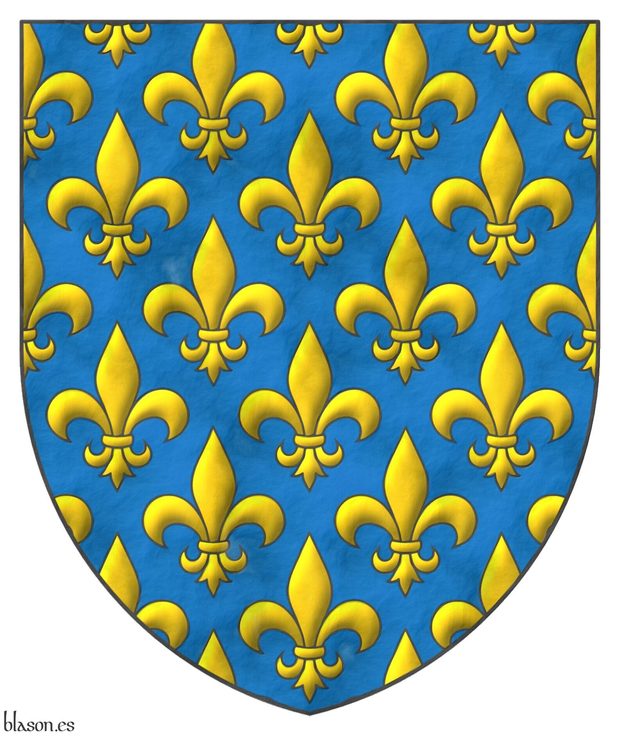
Wijnbergen, unknown authors, «Wijnbergen Armorial», currently located in The Hague and owned by the Royal Dutch Society of Genealogy and Heraldry, Île-de-France, 1265.
This armorial is called «Wijnbergen» because it was named after one of its early owners, and the names of its authors are unknown. I have retained this name in the key to this bibliographic reference for easier identification.
Among known manuscripts, it is the oldest armorial of French heraldry.
It is composed of 15 parts, although some authors divide it into 23, belonging to 2 different temporal stages of creation: a 1st stage from 1265 to 1270 and a 2nd stage, more difficult to date, from 1270 to 1285.
The armorial is written in French and contains a total of 1,312 coats of arms, of which 256 belong to the 1st stage and 1,056 to the 2nd stage.
Those of the 1st stage belong to the vassals of the Île-de-France under the reign of Luis IX de Francia, Saint Louis King of France.
Those of the 2nd stage, probably already under the reign of Felipe III de Francia, contain coats of arms from Normandy, Anjou and Poitou, Lorraine, Germany, Artois, Champagne, Vermandois, Brittany, Beauvais, Burgundy, Brabant, Hainaut (Belgium), Flanders, and finally, the coats of arms of 25 kings, mainly European.
Bibliographical reference of century XIII.
Author: Wijnbergen, Anonymous.
The following articles cite this bibliographic reference:
External links:
-
Language
-
Categories of heraldry
-
Divisions of the field
- Without divisions
- Party per pale
- Party per fess
- Party per bend
- Party per bend sinister
- Tierce
- Tierce sinister
- Tierced per pale
- Tierced per fess
- Tierced per bend
- Tierced pallwise inverted
- Quarterly
- Quarterly per saltire
- Gyronny
- Party per fess, the chief per pale
- Party per pale, the sinister per fess
- Party per fess, the base per pale
- Party per pale, the dexter per fess
- Chapé
- Chaussé
- Embrassé
- Contre-embrassé
- Party per chevron
- Enté
- Enté en point
- Flanched
-
Metals
-
Colours
-
Furs
-
Other tinctures
-
Ordinaries and sub-ordinaries
-
Diminutives of the ordinaries
-
Geometric charges
-
Composite ordinaries
-
Inanimate charges from Nature
Atom, Crescent, Diamond, Emerald, Estoile, Increscent, Lightning flash, Moon, Mount, Mullet, Mullet of four points, Orbital, Plough of Ursa Major, Rainbow, Ray of the sun, River, Sea, Snowflake, Sun, Sun in splendour, Sun of May, Trimount, Water and Wave.
-
Vegetal charges from Nature
Acorn, Apple, Apple tree, Ash, Bluebonnet, Camellia, Chrysanthemum, Cinquefoil, Cornflower, Dogwood flower, Double rose, Elm, Fleur de lis, Flower, Gourd, Holm oak, Hop cone, Kapok tree, Laurel, Lily, Linden, Lotus flower, Madonna lily, Mexican cedar tree, Oak, Olive tree, Palm tree, Plantain plant, Pomegranate, Poplar leaf, Rose, Shamrock, Sunflower, Thistle, Tree, Tulip, Vine and Wheat.
-
Animal charges from Nature
Badger, Bald eagle, Barbel, Barn owl, Bear, Beaver, Beetle, Bighorn sheep, Blackbird, Boar, Brach hound, Bull, Doe, Dog, Dolphin, Dove, Eagle, Elephant, Falcon, Female figure, Fish, Flame, Fly, Fox, Frog, Goat, Goldfinch, Goose, Heron, Horse, Hummingbird, Jaguar, Lark, Leopard, Lion, Lion passant, Lion rampant guardant, Lioness, Lynx, Male figure, Martlet, Merino ram, Owl, Panther, Parrot, Peacock, Pelican, Pelican in her piety, Puffin, Quetzal, Raven, Roe deer, Rooster, Savage, Seagull, Serpent, She-wolf, Stag, Starling, Talbot, Tyger, Vulture, Warren hound and Wolf.
-
Parts of natural charges
Arm, Beak, Branch, Caboshed, Chest, Claw, Covert, Dorsal fin, Eagle claw, Ermine spot, Escallop, Feather, Foot (palmiped), Foreleg, Forepaw, Hand, Head, Heart, Hoof, Leaf, Neck, Ostrich feather, Palm frond, Paw, Roe deers' attires, Shoulder, Sprig, Stags' attires, Stem, Swallow-tail, Tail, Tail addorsed, Tail fin, Talon, Tooth, Trunk, Trunk (elephant), Two hands clasped, Two wings in vol, Udder, Wheat spike, Wing and Wrist.
-
Artificial charges
Ace of spades, Anchor, Anvil, Arch, Arm vambraced, Armillary sphere, Arrow, Axe, Bell, Bell tower, Beret, Bonfire, Book, Bookmark, Bow, Branding iron, Bridge, Broken, Buckle, Cannon, Cannon dismounted, Cannon port, Canopy roof, Carbuncle, Castle, Celtic Trinity knot, Chain, Chess rooks, Church, Clarion, Clay pot, Closed book, Club, Column, Comb, Compass rose, Conductor's baton, Cord, Covered cup, Crozier, Crucible, Cuffed, Cup, Cyclamor, Dagger, Double vajra, Drum, Ecclesiastical cap, Fanon, Federschwert, Fleam, Four crescents joined millsailwise, Galician granary, Garb, Gauntlet, Geometric solid, Grenade, Halberd, Hammer, Harp, Host, Hourglass, Key, Key ward, Knight, Knot, Lantern, Letter, Line, Loincloth, Menorah, Millrind, Millstone, Millwheel, Monstrance, Mortar, Mullet of six points pierced, Nail, Non-classic artifact, Norman ship, Number, Oar, Oil lamp, Open book, Page, Pair of scales, Parchment, Pestle, Piano, Pilgrim's staff, Plough share, Polish winged hussar, Port, Portcullis, Potent, Quill, Ribbon, Rosette of acanthus leaves, Sabre, Sackbut, Sail, Scroll, Scythe, Sheaf of tobacco, Ship, Skirt, Spear, Spear's head, Stairway, Star of David, Step, Sword, Symbol, Tetrahedron, Torch, Tower, Trident, Trumpet, Turret, Two-handed sword, Wagon-wheel, Water-bouget, Wheel, Winnowing fan and With a turret.
-
Immaterial charges
Angel, Archangel, Basilisk, Dragon, Dragon's head, Garuda, Golden fleece, Griffin, Heart enflamed, Justice, Mermaid, Our Lady of Mercy, Ouroboros, Paschal lamb, Pegasus, Phoenix, Sacred Heart of Jesus, Saint George, Sea-griffin, Trinity, Triton, Unicorn, Winged hand and Wyvern.
-
External elements
-
Heraldic creations
-
References
-
Formats
-
Keywords on this page
Point upwards, Armorial roll, Azure, Bend, Bibliography, Surmounted, Chain, In black and white, In color, In fess, Sword, Fleur de lis, Gules, Castilian language, Valencian language, Manuscript, Orle, Or, Argent, Without divisions, Kingdom of Castile and Leon, Kingdom of France, Kingdom of England, Sable, Semé and Century XIII.

